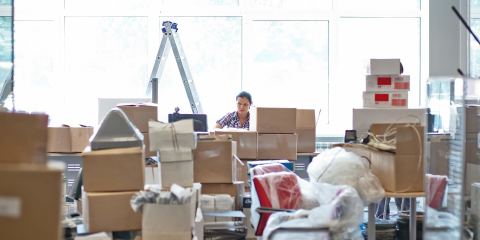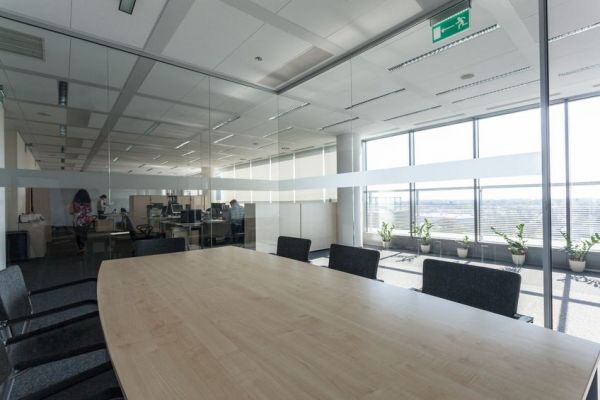Office relocations are a lot of work—on top of coordinating the move, packing everything, keeping employees productive and happy, sticking to the moving schedule, and running the business as usual (phew!), you also need to consider moving safety.
Office move safety considerations may include more than you anticipate, so we’ve put together a list of five common safety hazards and concerns you should plan for when relocating your office. Here they are:
1. Trip and fall hazards & obstruction of walkways
In the (hopefully) organized chaos of a move, boxes, furniture, and other odds and ends will be stacked on the floor out of necessity. While it may be necessary to place them there, it’s important to be mindful of where you are putting these items to prevent them from turning into safety hazards and avoid injuries caused by falls or collisions.
Keep items clear from these areas:
- Common walkways
- Hallways
- Any cupboards, cabinets, closets, drawers or desks that employees still require access to
- Doorways
- Fire exits
- Stairways
- Elevator doors
TSI TIP: Be careful not to stack boxes and other items too high. Tall stacks can quickly become unstable and tip over, and are also at greater risk of getting knocked over in the midst of a move, leading to injury or damage to your office supplies and equipment.
2. Lifting boxes and furniture
Another concern when relocating your office is proper lifting and moving technique. Employees may not be well-versed with proper lifting techniques or may have pre-existing injuries or disabilities, making it easy for injuries or re-injuries to take place.
It is often best to hire properly trained movers to do the heavy lifting, but if that is not possible or they aren’t scheduled to come until after everything is packed, make sure your employees have the right materials on hand for moving equipment safely and that they receive training to help them avoid injury:
Select and have the right materials available, including:
- Boxes or containers with handles.
- Light and effective packing materials (packing paper, etc).
- Markers, labels, tape.
- Hand carts and trolleys.
- Moving straps.
Packing considerations
- Pack boxes lightly enough that they can be lifted easily by a single employee.
- Seal boxes carefully to ensure they will not break open while being carried.
- Label boxes clearly and indicate if they are fragile or heavy, what their destination is, as well as which direction should be facing up.
Avoiding injury by using good lifting technique
- Place feet shoulder-width apart.
- Squat down, bending your knees and hips but keeping your back straight.
- Throughout the lift, keep your back straight, chest forward, and shoulders back.
- Get as close as possible to the box or item before lifting, and hold it close to your chest as you lift.
- Do not lift the item above shoulder height.
- Lift slowly, unbending your knees and hips and engaging your leg muscles and core.
- Do not twist your torso while lifting or carrying the item—keep your shoulders and hips in line.
- Lower the item carefully, bending your knees and hips and keeping your back straight—the same as you did when picking the item up.
3. Cleaning and cleaning products
Cleaning is one part of moving that often gets forgotten or overlooked until the time comes to put on your gloves and get scrubbing. With the work of cleaning comes concerns around cleaning products and the safety considerations those items require:
- Let employees know about potential hazards and the safety precautions that are being taken to keep them safe. If any employees have allergies or sensitivities to these products, give them the option to work from home on days when cleaning will be done.
- Before using cleaning products, check the instructions either directly on the package itself or on the Material Safety Data Sheets (MSDSs or SDSs).
- Prepare the appropriate safety precautions (e.g. Gloves, masks, safety goggles, aprons).
PRO TIP: Consider hiring professional cleaners if your office doesn't have them already and arrange for any move-related cleaning to be done outside of working hours.
4. Dust, debris, and other particulates
During the cleaning, packing, and moving process, dust, debris, and other particulates will almost certainly be kicked up—especially if any repairs or renovations are being done at either the old office or your new space. While cleaning, you may also encounter things like dust mites and mold. This can trigger some allergies or asthmas, and requires some additional considerations:
- Have disposable particulate respirators and respirator masks with HEPA filters on hand for employees who will be exposed to these particulates.
- Relax dress codes and advise employees to wear clothes that can be machine washed, or provide coveralls.
5. Work-station set up
Once you’ve arrived at your new office, take your fresh start as an opportunity to set up furniture and office stations so that they are ergonomically correct to ensure they are safe for employees. Have your staff set up their desks to their liking, but make sure their offices are ergonomically evaluated by a professional so that your staff will not suffer any repetitive task injuries.
- Have desks, chairs, and computer screens raised to the appropriate height.
- Provide training on correct ergonomic posture and workflow to help prevent injuries.
- Provide any necessary or requested equipment to make workflow easier and less strenuous.
Conclusion
It is easy to get swept up in the excitement and stress of an office move, but it’s important to take the time to plan for safety and take steps to enact that plan by:
- Keeping pathways clear of obstructions
- Properly packing items so that they can be transported easily
- Lifting boxes and furniture using correct form
- Taking care with cleaning products and using safety equipment when necessary
- Providing safety equipment for dust, debris, and particulates
- Taking the time to set up new offices ergonomically
Still have safety concerns? Consider hiring professionals to help you with your move.
Office relocation services
TSI can help your office relocation run smoothly so you can get back to business.




